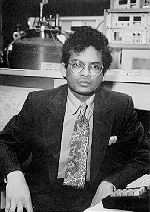
Timir Datta
Professor
PSC 501Physics and Astronomy
University of South Carolina
Columbia, South Carolina 29208
(803) 777-2075
Education
- Ph. D. Experimental Condensed Mat. (1979), Tulane University.
- M.S. Plasma Theory (1974), Boston College.
- B. S. (1969), Calcutta University.
Research Interests
Experimental and mathematical topics in the areas of condensed matter physics are of interest to our group. Current research projects involve high temperature superconductivity, mesoscopic quantum transport, deterministic chaos, and the effects of disorder in linear and non-linear systems. When the electrons in a medium interact among themselves and with their environment then phase transitions can take place. In the case of many solids such as some copper oxide compounds the electrons undergo superconducting phase transitions. In these solids, this process can be observed at temperatures above the boiling point of liquid air. Such high temperature superconductivity was unthinkable 10 years ago. The exact process of this "high temperature" mechanism is a topic of research in our program. Many condensed matter states have transitional symmetry; this may be continuous for discreet. If this symmetry holds over a long range then the problem can be greatly simplified. If translational symmetry is randomly broken by disorder then many well known processes behave in unexpected fashions. Localization of waves is such a novelty. Localization was first studied in the context of quantum behavior of electrons but in the last few years there has been evidence of localization even in the case of classical waves. We are involved in several research projects on this topic. In the last decade or so an unexpectedly rich complexity has been discovered in nonlinear systems giving rise to the so-called deterministic chaos. We are studying a number of non-linear chaotic behaviors in high temperature superconductors and mechanical oscillators. Our laboratory is equipped with three superconducting quantum interference device (SQUID) susceptometers and magnetometers. Several SQUID measurement electronic, liquid helium cryogenics, and magneto-transport apparatus are also available. We also have high and ultra high vacuum chambers for thin film, multi-layer growth, and patterning in the laboratory. A scanning tunneling microscope (STM) with a temperate and magnetic field state is used to study quantum mesoscopic transport in nano-scale conductors. We are directing a project with the South Carolina Institute of Superconductivity with Federal Support to assemble an electronic encyclopedia of the physical properties of superconductors. This will eventually be available on-line for the convenience of other research.
Selected Publications
- "Oxide Superconductors: Physical Properties," T. Datta in Concise Encyclopedia of Magnetic and Superconducting Materials, ed., Jan Evetts, Pergamon, Oxford (1992).
- "Magnetic Properties: of Tl-Superconductors," T. Datta in Thallium-based High-temperature Superconductors, ed., A. M. Hermann and Yakmi, Marcel Dekker, New York (1993).
- "Superconductivity Above 130 K in the Hg-Pb-Ba-Ca-O System," Z. Iqbal, T. Datta, D. Kirven, A. Lungu, J. C. Bakky, F. J. Woens, A. G. Rinzler, D. Yang, and F. Reidinger, Physical Review, B49, 12322 (1994).
- "Techniques for Obtaining Far Infrared Transmission Spectra of High Tc Superconductors and Related Synthetic Precursors,"
- H. D. Bist, H. Ning, T. Datta, T. S. Little, and J. R. Durig, Specrochemica Acta 50A, 473 (1994).